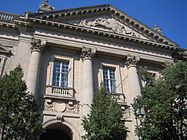File:Siddur WDL7501.pdf

Original file (2,935 × 3,750 pixels, file size: 31.59 MB, MIME type: application/pdf, 228 pages)
Captions
Captions
Summary
[edit]| Русский: Сиддур
Français : Siddour English: Siddur 中文:西都尔 Português: Sidur العربية: السيدور Español: Sidur עברית: סידור ( |
|||||||||||||||||||||||||||
|---|---|---|---|---|---|---|---|---|---|---|---|---|---|---|---|---|---|---|---|---|---|---|---|---|---|---|---|
| Title |
Русский: Сиддур
Français : Siddour
English: Siddur
中文:西都尔
Português: Sidur
العربية: السيدور
Español: Sidur
עברית: סידור |
||||||||||||||||||||||||||
| Description |
Русский: Этот кодекс считается одним из наиболее древних из сохранившихся в Испании средневековых махзоров (иудейских молитвенников, содержащих молитвы на праздники). Он датируется примерно началом XIV века. Он написан на иврите сефардскими квадратными буквами и состоит из двух отдельных частей, позднее переплетенных вместе. Более объемную часть составляет "Хаггада шель Песах" (текст службы, проводимой в начале Пасхи). Она содержит пиют (литургические стихи, которые поют или произносят нараспев) в честь Пасхи и арамейский таргум (перевод) книги "Исход", а также литургические стихи в честь Шавуота (праздника дарования евреям Торы) и Суккота (праздника кущей). Наиболее характерной особенностью кодекса является способ иллюстрирования ключевых слов службы, при котором буквам придается вид зооморфных и антропоморфных фантастических существ. Этот стиль был широко распространен в средневековых иудейских рукописях, созданных в Испании. Изначально рукопись находилась в знаменитой коллекции рукописей и инкунабул Александра, графа Гамильтона, которая была приобретена Прусским государством в 1882 г. С 1919 г. предметы коллекции, относящиеся к иудаизму, находятся в фонде Восточного отдела Берлинской государственной библиотеки.
Кодекс; Хаггада; Иллюминирование рукописей; Литургии; Поэзия; Молитвы Français : Ce codex est largement considéré comme l'un des mahzorim (livres de prières pour les fêtes juives) d'Espagne les plus anciens parmi les livres médiévaux encore existants. Il remonte probablement au début du XIVe siècle. Écrit en hébreu en caractères carrés séfarades, il contient deux parties distinctes qui furent reliées ensemble par la suite. La plus grande partie forme une Haggadah shel Pesach (le texte de l'ordre du service utilisé au début de la Pâque juive). Elle inclut des piyoutim (poèmes liturgiques, habituellement chantés ou psalmodiés) pour la Pâque juive et des targoum araméen (traduction) de l'Exode, suivie de poésie liturgique pour Chavouot (qui commémore le don de la Torah aux Israélites) et Souccot (la Fête des Tarbenacles). Comme trait le plus caractéristique, on notera la façon dont les mots clés de la liturgie sont illustrés, les caractères étant transformés en grotesques créatures zoomorphes ou anthropomorphes, une mode largement répandue dans les manuscrits juifs médiévaux en Espagne. Le manuscrit appartenait à l'origine à la fameuse collection de manuscrits et d'incunables d'Alexandre, comte d'Hamilton, qui fut acquise en 1882 par l'État prussien. Depuis 1919, les éléments hébreux de la collection sont conservés par le Département oriental de la Bibliothèque d'État de Berlin.
Codex; Haggadah; Enluminures; Liturgies; Poésie; Prières English: This codex is widely considered to be one of the most original of extant medieval mahzorim (Jewish holy day prayer books) from Spain, dating probably from the beginning of the 14th century. Written in Hebrew in Sephardic square characters, it contains two distinct parts that later were bound together. The larger part forms a Haggadah shel Pesach (the text of the order of service used at the beginning of Passover). It includes piyutim (liturgical poems, usually sung or chanted) for Passover and the Aramaic targum (translation) of Exodus, followed by liturgical poetry for Shavuot (which commemorates the gift of the Torah to the Israelites) and Sukkot (the Feast of Tabernacles). Most characteristic is the way key words of the liturgy are illustrated, the characters being transformed into zoomorphic and anthropomorphic grotesque creatures, a fashion that was widespread in medieval Jewish manuscripts in Spain. The manuscript originally belonged to the famous collection of manuscripts and incunabula owned by Alexander, Earl of Hamilton, which was acquired in 1882 by the Prussian state. Since 1919, the Hebrew items from the collection have been in the holdings of the Oriental Department of the Berlin State Library.
Codex; Haggadot; Illuminations; Liturgies; Poetry; Prayers 中文:此手抄本被普遍视为现存的西班牙中世纪 mahzorim(犹太宗教节日祈祷书)中最古老的作品之一,可追溯至 14 世纪初期。它采用希伯来语和西班牙系犹太人的方块字书写,包含两个不同的部分,后又被装订在一起。内容较多的一部分是《逾越节庆典手册》(逾越节开始时使用的礼拜程序文本),其中包括庆祝逾越节时使用的 piyutim(礼拜诗,通常用于唱诵或吟诵)、阿拉姆语的《出埃及记》targum(译文)以及五旬节(纪念上帝颁给以色列人《旧约》前五卷的日子)和住棚节时使用的礼拜诗。此手抄本最大的特点是祷告文的关键字采用了独特的方式进行装饰——将字符转换为动物形和人形的奇怪生物,这种风格在西班牙的中世纪犹太族手稿中广泛流行。手抄本最初为著名的手稿和古版书收藏家亚历山大·汉密尔顿伯爵 (Alexander, Earl of Hamilton) 所有,后于 1882 年被普鲁士王国获得。自 1919 年起,收藏品中的希伯来物件就被收藏在柏林国立图书馆中。
手抄本; 哈加达; 插图; 敬拜礼仪; 诗歌; 祈祷文 Português: Este códice é considerado um dos mais originais mahzorim (Livros de orações diárias do sagrado judaico) dos sobreviventes medievais da Espanha, que data provavelmente do início do século XIV. Escrito em hebraico sefardita em caracteres quadrados, contém duas partes distintas, que mais tarde foram unidas. A parte maior forma um Haggadah shel Pesach (o texto da ordem de serviço utilizado no início da Páscoa). Ele inclui piyutim (poemas litúrgicos, geralmente cantados ou entoados) para a Páscoa e o aramaico targum (tradução) do Êxodo, seguido da poesia litúrgica da Shavuot (que comemora a revelação da Torá aos israelitas) e da Sucot (Festa dos Tabernáculos). Mais característico é a forma como as palavras-chave da liturgia são ilustradas, os personagens se transformando em criaturas grotescas zoomórficas e antropomórficas, uma moda que foi difundida em manuscritos medievais judaicos da Espanha. O manuscrito pertenceu originalmente à famosa coleção de manuscritos e incunábulos de propriedade de Alexander, conde de Hamilton, que foi adquirida em 1882 pelo Estado prussiano. Desde 1919, os itens da coleção hebraica se encontravam em posse do Departamento Oriental da Biblioteca Estadual de Berlim.
Códice; Haggadot; Iluminuras; Liturgias; Poesia; Orações العربية: تُعتبر هذه المجموعة من المخطوطات إحدى الـ<em>mahzorim</em> (الكتب المقدسة اليهودية للصلوات اليومية) الأصلية الباقية من العصور الإسبانية المتوسطة، ومن المرجح أنها تعود لأوائل القرن الرابع عشر. يحتوي الكتاب على جزئين مستقلين تم جمعهما ببعضهما البعض لاحقاً وهما مكتوبان باللغة العبرية بالحروف السفاردية المربعة. يُمثل Haggadah shel Pesach (نص طقوس الصلاة المُستخدمة عند بداية عيد الفصح اليهودي) الجزء الأكبر من الكتاب. ويشمل الكتاب <em>piyutim</em> (أناشيد دينية يُمكن غنائها أو ترنيمها) لتُردَد في عيد الفصح اليهودي والـ<em>targum</em> (ترجمة) الآرامية لسُفُر الخروج، تتبعها أناشيد دينية خاصة بعيد الأسابيع (الذي يُخَلِد ذكرى نزول التوراة على بني إسرائيل) والـSukkot (عيد المظال). ويتميز الكتاب بالطريقة المكتوب بها الكلمات الرئيسة للأناشيد، حيث كُتِبَت الحروف على هيئة مخلوقات في صورة حيوانات أو بشر وكانت تلك الصيحة متبعة في كتابة المخطوطات في العصور اليهودية الوسطى في إسبانيا. تنتمي المخطوطة في الأصل إلى المجموعة الشهيرة من المخطوطات والكتب المطبوعة قبل عام 1500 م، والتي امتلكها إسكندر إيرل "هاملتون" وتحصلت عليها كومة بروسيا عام 1882. أصبحت ملكية الكتب اليهودية في المجموعة تعود لقسم الحضارة الشرقية في مكتبة ولاية برلين منذ عام 1919.
المخطوطات; الهاغدوت; الزخارف; الأناشيد الدينية; الشعر; الأدعية Español: Muchos consideran que este códice es uno de los más originales mahzorim (libros sagrados judíos de oración diaria) de España medieval que han sobrevivido, que data probablemente de comienzos del siglo XIV. Escrito en hebreo en caracteres cuadrados sefardíes, consta de dos partes distintas que luego se encuadernaron juntas. La parte mayor forma un Haggadah shel Pesach (el texto del orden del servicio utilizado al comienzo de la Pascua). Contiene piyutim (poemas litúrgicos, normalmente cantados o recitados) para Pascua y la targum (traducción) en arameo del Éxodo, seguido de poesía litúrgica para Shavuot (que conmemora el regalo de la Torá a los hijos de Israel) y Sucot (la Fiesta de los Tabernáculos). Lo más característico es la forma en que las palabras clave de la liturgia están ilustradas: los personajes se transforman en grotescas criaturas zoomorfas y antropomorfas, una moda que se extendió en manuscritos medievales judíos en España. El manuscrito perteneció originalmente a la famosa colección de manuscritos e incunables de Alexander, conde de Hamilton, que adquirió el estado prusiano en 1882. Desde 1919, los ítems hebreos de la colección han estado en tenencia del Departamento Oriental de la Biblioteca Estatal de Berlín.
Códice; Hagadot; Iluminaciones; Liturgias; Poesía; Oraciones |
||||||||||||||||||||||||||
| Date |
circa between 1300 and 1350 date QS:P571,+1350-00-00T00:00:00Z/7,P1319,+1300-00-00T00:00:00Z/9,P1326,+1350-00-00T00:00:00Z/9 |
||||||||||||||||||||||||||
| Medium |
Русский: Рукописи
Français : Manuscrits
English: Manuscripts
中文:手稿
Português: Manuscritos
العربية: مخطوطات
Español: Manuscritos |
||||||||||||||||||||||||||
| Dimensions |
English: 106 pages |
||||||||||||||||||||||||||
| Collection |
institution QS:P195,Q170109 |
||||||||||||||||||||||||||
| Place of creation | Spain | ||||||||||||||||||||||||||
| Notes | Original language title: סידור | ||||||||||||||||||||||||||
| References | http://hdl.loc.gov/loc.wdl/deus5b.7501 | ||||||||||||||||||||||||||
| Source/Photographer | |||||||||||||||||||||||||||
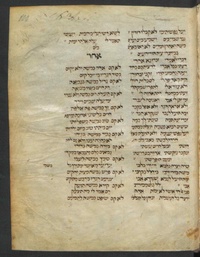 |
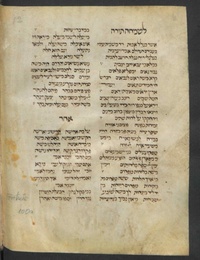 שמחת תורה |
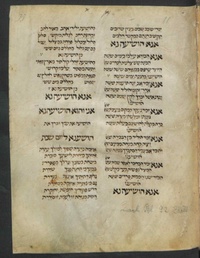 |
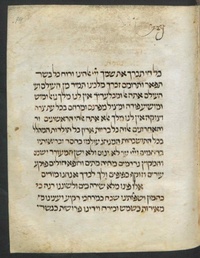 |
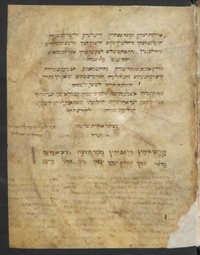 פסח |
Licensing
[edit]|
This is a faithful photographic reproduction of a two-dimensional, public domain work of art. The work of art itself is in the public domain for the following reason:
The official position taken by the Wikimedia Foundation is that "faithful reproductions of two-dimensional public domain works of art are public domain".
This photographic reproduction is therefore also considered to be in the public domain in the United States. In other jurisdictions, re-use of this content may be restricted; see Reuse of PD-Art photographs for details. | |||||
File history
Click on a date/time to view the file as it appeared at that time.
| Date/Time | Thumbnail | Dimensions | User | Comment | |
|---|---|---|---|---|---|
| current | 16:22, 14 March 2014 |  | 2,935 × 3,750, 228 pages (31.59 MB) | Fæ (talk | contribs) | =={{int:filedesc}}== {{Artwork |artist = |author = |title ={{ru|1=Сиддур}} {{fr|1=Siddour}} {{en|1=Siddur}} {{zh|1=西都尔}} {{pt|1=Sidur}} {{ar|1=السيدور}} {{es|1=Sidur}} |description ={{ru|1=Этот кодекс считается о... |
You cannot overwrite this file.
File usage on Commons
The following page uses this file:
Metadata
This file contains additional information such as Exif metadata which may have been added by the digital camera, scanner, or software program used to create or digitize it. If the file has been modified from its original state, some details such as the timestamp may not fully reflect those of the original file. The timestamp is only as accurate as the clock in the camera, and it may be completely wrong.
| Image title | This document was downloaded from the World Digital Library (http://www.wdl.org). Go to http://hdl.loc.gov/loc.wdl/wdl.7501 for more information about this item. |
|---|---|
| Keywords | This document was downloaded from the World Digital Library (http://www.wdl.org). Go to http://hdl.loc.gov/loc.wdl/wdl.7501 for more information about this item. |
| Conversion program | Mac OS X 10.6.8 Quartz PDFContext |
| Encrypted | no |
| Page size |
|
| Version of PDF format | 1.3 |

